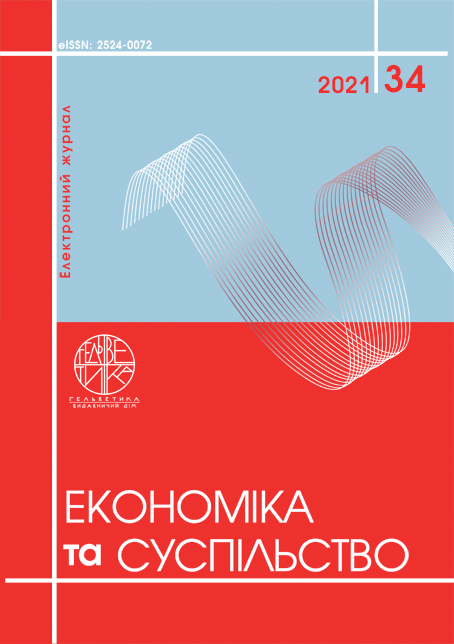FINANCIAL MOTIVES FOR THE APPLICATION OF BLOCKCHAIN TECHNOLOGIES IN BANKING
Abstract
The article considers the trends of the modern banking market and identifies prospects for the blockchain technologies use in the financial and economic activities of bank institutions. It was revealed that Ukraine is taking steps to formalize and delineate relations with virtual assets in the legal field. At the moment, the Ukrainian legislation related to the research topic is being clarified and finalized. Scientists have found that opinions on the use of blockchain technologies differ. According to some pessimistic forecasts, this technology will cause significant obstacles for bank institutions, but other scientists believe that blockchain technologies can help develop financial relations. The world experience of using blockchain technologies in banking has been studied. Currently, there is a growing number of businesses that are already involved in blockchain-related projects. It is also found that projects related to blockchain technologies in the banking sector are currently being developed and implemented. Among the implementers of such projects are: JP Morgan Chase, Bank of America, BNP Paribas and Fujitsu and JBA. The concept of blockchain as a distributed book technology and the principles of this technology are defined. The main advantages, disadvantages and ambiguous characteristics of the blockchain from the standpoint of bank security are formulated. The advantages of the blockchain include: reliability, compromise and security. The disadvantages of the studied technology include: energy dependence, energy consumption, new cyber vulnerabilities and the complexity of financial monitoring. It was found that the ambiguous characteristics of blockchain technologies include: confidentiality, transparency, decentralization, lack of standards and novelty for customers. Obstacles to the implementation of the blockchain in financial intermediation have been identified. It is determined that the main financial motives for the use of blockchain in banking include the following: efficiency, security, autonomy and control. Characteristics that are consistent or conflicting with individual motives are identified.
References
Законопроект «Про віртуальні активи». URL: http://w1.c1.rada.gov.ua/pls/zweb2/webproc4_1?pf3511=69110 =
Офіційний сайт Верховної Ради України. URL: https://www.rada.gov.ua/news/Novyny/213503.html. =
Dancho Petrov (2020) Blockchain Ecosystem in the Financial Services Industry. FAIMA Business & Management Journal. Volume 8, Issue 1. 19-29. URL: http://www.faimajournal.ro/full_issue/26.%20INTERIOR%20Revista%20FAIMA%20Vol%208%20-%20Issue%201%20[March%202020].pdf#page=19.
Rebecca Lewis, John McPartland, Rajeev Ranjan (2019) Blockchain and financial market innovation. J.P. Morgan Center For Commodities. UNIVERSITY OF COLORADO DENVER BUSINESS SCHOOL. URL: http://www.jpmcc-gcard.com/wp-content/uploads/2019/03/GCARD-Summer-2019-Chicago-Fed.pdf.
Dulani Jayasuriya Daluwathumullagamage, Alexandra Sims. Fantastic Beasts: Blockchain Based Banking. Journal of Risks and Financial Management. URL: http://www.mdpi.com/1911-8074/14/4/170
Derrick Bonyuet (2020) Overview and Impact of Blockchain on Auditing. The International Journal of Digital Accounting Research. Vol. 20. 31-43. DOI: https://doi.org/10.4192/1577-8517-v20_2
Manlu Liu, Kean Wu, Jennifer Jie Xu (2019). How Will Blockchain Technology Impact Auditing and Accounting: Permissionless versus Permissioned Blockchain. American Account Association. Vol. 13, Number 2. 19-29. DOI: https://doi.org/10.2308/ciia-52540
Marion Pauline Gauthier, Nathalie Brender (2021). How do the current auditing standards fit the emergent use of blockchain? Managerial Auditing Journal. Vol. 36 No. 3. 365-385. DOI: https://doi.org/10.1108/MAJ-12-2019-2513
Thomson Reuters . KYC Challenges in 2017: A Focus on the Impact of Global Regulations in the United States. URL: https://risk.thomsonreuters.com/..kyc-challenges-2017-usa.pdf.
Що таке Блокчейн (Blockchain)? Технологія розподіленого реєстру простими словами. URL: http://bitcoin-crypto-portal.com/scho-take-blokcheyn-blockchain-tehnolog-ya-rozpod-lenogo-re-stru-prostimi-slovami/.
The BlueNoroff cryptocurrtncy hunt is still on. URL: https://securelist.com/the-bluenoroff-cryptocurrency-hunt-is-still-on/105488.
Najoua Elommal, Riadh Manita (2021). How blockchain innovation could affect the audit proffesion: a qualitative study. «Journal of Innovation Economics & Management». Prepublication.103. DOI: https://doi.org/10.3917/jie.pr1.0103
Higginson, M., Nadeau, M., Rajgopal, K. (2019) Blockchain’s Occam Problem. McKinsey on Payment. URL: https://www.mckinsey.com/industries/financialservices/our-insights/blockchains-occam-problem.
The bill "On virtual assets". Retrived from: http://w1.c1.rada.gov.ua/pls/zweb2/webproc4_1?pf3511=69110
Official site of the Verkhovna Rada of Ukraine. Retrived from: https://www.rada.gov.ua/news/Novyny/213503.html.
Dancho Petrov (2020) Blockchain Ecosystem in the Financial Services Industry. FAIMA Business & Management Journal. Volume 8, Issue 1. 19-29. Retrived from: http://www.faimajournal.ro/full_issue/26.%20INTERIOR%20Revista%20FAIMA%20Vol%208%20-%20Issue%201%20[March%202020].pdf#page=19.
Rebecca Lewis, John McPartland, Rajeev Ranjan (2019) Blockchain and financial market innovation. J.P. Morgan Center For Commodities. UNIVERSITY OF COLORADO DENVER BUSINESS SCHOOL. Retrived from: http://www.jpmcc-gcard.com/wp-content/uploads/2019/03/GCARD-Summer-2019-Chicago-Fed.pdf.
Dulani Jayasuriya Daluwathumullagamage, Alexandra Sims. Fantastic Beasts: Blockchain Based Banking. Journal of Risks and Financial Management. Retrived from: http://www.mdpi.com/1911-8074/14/4/170.
Derrick Bonyuet. (2020) Overview and Impact of Blockchain on Auditing. The International Journal of Digital Accounting Research. Vol. 20. 31–43. DOI: https://doi.org/10.4192/1577-8517-v20_2
Manlu Liu, Kean Wu, Jennifer Jie Xu (2019) How Will Blockchain Technology Impact Auditing and Accounting: Permissionless versus Permissioned Blockchain. American Account Association. Vol. 13, Number 2. 19-29. DOI: https://doi.org/10.2308/ciia-52540
Marion Pauline Gauthier, Nathalie Brender (2021) How do the current auditing standards fit the emergent use of blockchain? Managerial Auditing Journal. Vol. 36 No. 3. 365-385. DOI: https://doi.org/10.1108/MAJ-12-2019-2513
Thomson Reuters . KYC Challenges in 2017: A Focus on the Impact of Global Regulations in the United States. Retrived from: https://risk.thomsonreuters.com/..kyc-challenges-2017-usa.pdf.
What is Blockchain? Distributed registry technology in simple words. Retrived from: http://bitcoin-crypto-portal.com/scho-take-blokcheyn-blockchain-tehnolog-ya-rozpod-lenogo-re-stru-prostimi-slovami/.
The BlueNoroff cryptocurrtncy hunt is still on. Retrived from: https://securelist.com/the-bluenoroff-cryptocurrency-hunt-is-still-on/105488.
Najoua Elommal, Riadh Manita (2021) How blockchain innovation could affect the audit proffesion: a qualitative study. «Journal of Innovation Economics & Management». Prepublication.103. DOI: https://doi.org/10.3917/jie.pr1.0103
Higginson, M., Nadeau, M., Rajgopal, K. (2019) Blockchain’s Occam Problem. McKinsey on Payment. Retrived from: https://www.mckinsey.com/industries/financialservices/our-insights/blockchains-occam-problem.


